1993 BUICK ROADMASTER change time
[x] Cancel search: change timePage 92 of 340

As you signal a turn or a lane change, if the arrows don't
flash but just stay on, a signal bulb may be burned out
and other drivers won't see your turn signal.
If a bulb is burned out, replace it to help avoid an
accident. If the green arrows don't go on at all when you
signal a turn, check the fuse (see "Fuses" in the Index)
and for burned-out bulbs.
If you have a trailer towing option with added wiring for
the .trailer lights, a different
turn signal flasher is used.
With this flasher installed, the signal indicator will flash
even if
a turn signal bulb is burned out. Check the front
and rear turn signal lights regularly to make sure they
are working.
Turn Signal Reminder
A chime will sound if your turn signal remains on after
having driven
1/2 mile, to remind you to turn off your
signal.
Operation of Lights
Although your vehicle's lighting system (headlamps,
parking lamps, fog lamps, side marker lamps and tail
lamps) meet all applicable Federal lighting
requirements, certain States and Provinces may apply their own lighting regulations that may require special
attention before you operate these lamps. For.example,
some jurisdictions may require that you operate your
lower beam lamps with fog lamps at -all times, or that
headlamps. be turned
on whenever you.must use your
windshield wipers. In addition, most jurisdictions
prohibit driving solely with parking lamps, especially at
dawn or dusk. It is recommended that you check with
you own State or Provincial highway authority. for
applicable lighting regulations.
Headlight High-Low Beam
To change the headlights.
l .from low beam to high or..'
:hi:& -to low, pull the turn
signal lever all the way
'toward you. Then .release it.
When the high beams are
on, a blue light, on the
instrument panel -also will
be on.
90
Page 105 of 340

Automatic Mirror (Option)
Your Buick may have the automatic inside mirror.
The automatic mirror adjusts for the glare
of headlights
behind you. It detects changes
in light, and then adjusts
for day
or night operation.
During the day the mirror reflects all the light from
behind your car. At night; when the glare
is too high, it
changes to the night mode. Then, it reflects only part of
the light from behind you. When the mirror changes to
the night-mode,jt holds that position until glare is no
longer present.
d
Time Delay
The mirror delays before switchingcfrom the night back
to the day position. This delay prevents rapid changing
of the mirror as you drive under li-ghts and through
traffic.
Reverse Gear Day Mode
The-reverse mode is another important €eature of the
automatic mirror. When the shift lever
is placed in "R'
(Reverse), the mirror shifts to the day mode. This gives
you a bright image in the mirror
as you back up.
Automatic/Off Switch
Push the switch up for the AUTO position. The switch
cap will light indicating the mirror will automatically
adjust for glare.
To turn the automatic adjust off, push the switch down.
Front Reading Lights
There are two reading lights located on .the rearview
mirror. Push the switch closest'to the light to turn it on
or off.
103
Page 161 of 340
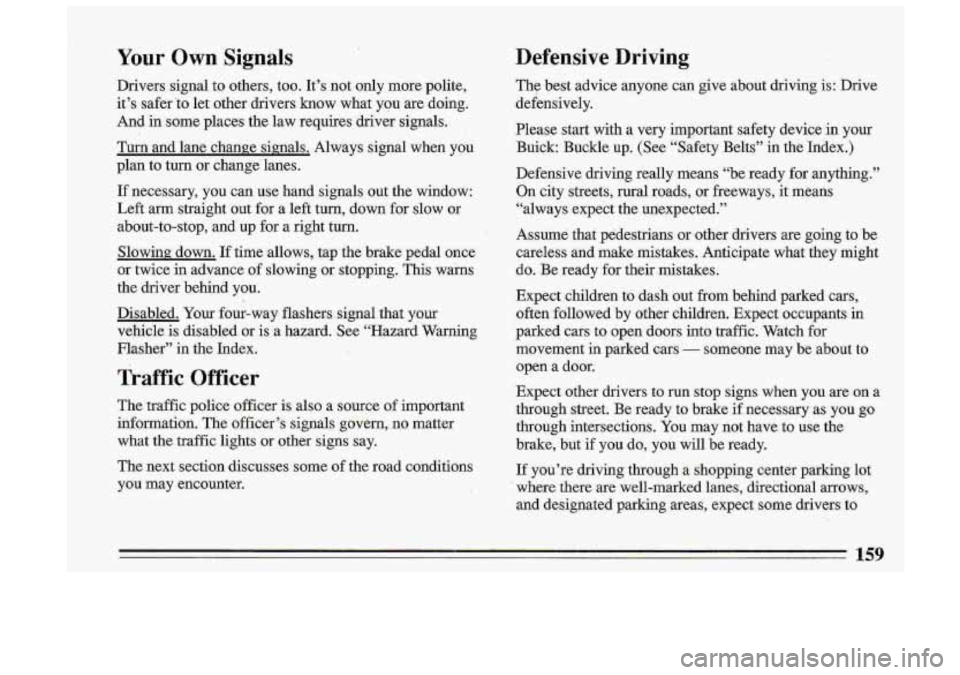
Your Own Signals Defensive Driving
Drivers signal
to others, too. It’s not only more polite,
it’s safer ‘to let other drivers know what you are doing.
And in some places the law requires driver signals.
Turn and lane change signals. Always signal when you
plan to turn or change lanes.
If necessary, you can
use hand signals out the window:
Left arm straight out for
a left turn, down- for slow or
about-to-stop, and up for a right turn.
Slowing. down. If time allows, tap the brake pedal once
or twice
in advance of slowing or stopping. This warns
the driver behind you.
Disabled. Your -four-way flashers signal that your
vehicle is disabled or is a hazard. See “Hazard Warning
Flasher” in the Index.
Traffic Officer
The traffic police officer is also a source of important
information.
The officer’s signals govern, no matter
what the traffic lights or other signs say.
The next section discusses some of the road conditions
you
may encounter. The
best advice anyone can give about driving is: Drive
i
defensively. !
Please start with a very important safety device in your
Buick: Buckle up. (See “Safety Belts” in the Index.) i
Defensive driving really means “be ready for anything.”
On city streets, rural roads, or freeways, it means
“always expect the unexpected.”
Assume that pedestrians or other drivers are going to be
careless and make mistakes. Anticipate what they might
do. Be ready for their mistakes.
Expect children to dash out from behind parked cas,
often-followed by other children. Expect occupants
in
parked cars to open doors into traffic., Watch for
movement
in parked cars - someone may be about to
open a door.
Expect other drivers to run stop signs when. you are on a
through street. Be ready to brake if necessary
as you go
through intersections. You may not have
to use the
brake, but if you do, you will be ready.
If you’re driving through a shopping center parking lot
where there are well-marked lanes, directional arrows,
and designated parking areas, expect.some drivers to
159
__
Page 201 of 340
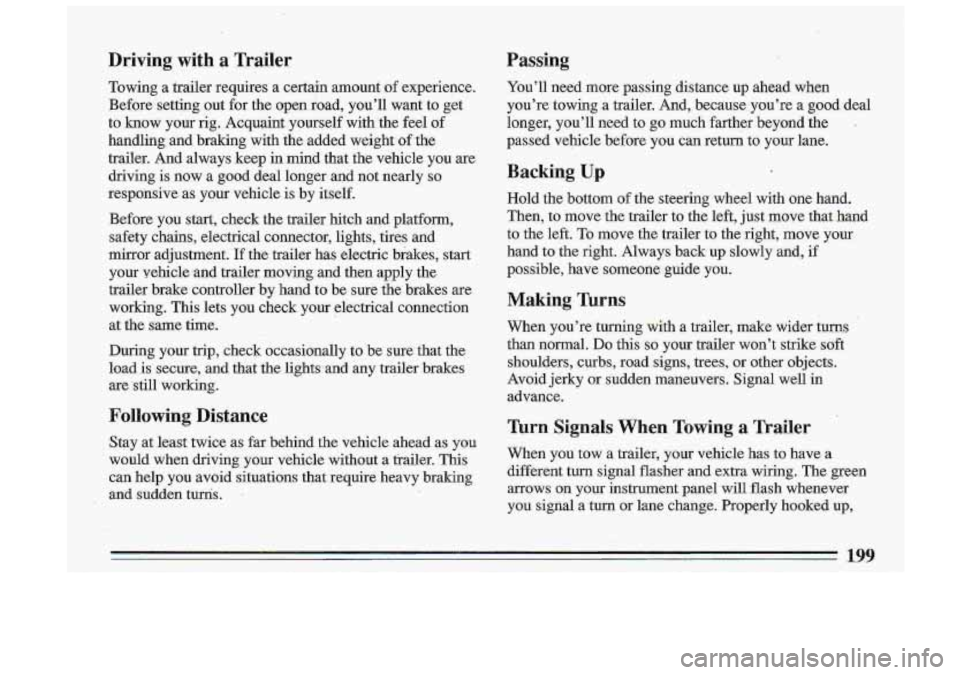
Driving with a Trailer
Towing a trailer requires a certain amount of experience. Before setting out for the open road, you’ll want to get
to
know your rig. Acquaint yourself with the feel of
handling and braking. with the added weight of the
trailer. And always keep in mind that the vehicle you are
driving is now
a good deal longer and not nearly so
responsive as your vehicle is by itself.
Before you start, check the trailer hitch and platform,
safety chains, electrical connector, lights, tires and
mirror adjustment.
If the trailer has electric biakes, start
your yehicle and trailer moving and then apply the
trailer brake controller by hand to be sure the- brakes are
working. This lets you check your electrical connection
at the same time.
During your trip, check occasionally to
be sure that the
load
is secure, and that the Lights.and any trailer brakes
are .still working.
Following Distance
Stay at least twice as far behind the vehicle ahead as you
would when driving your vehicle without a trailer. This
can help
you avoid situations that require heavy braking
and sudden turris.
.
Passing
You’ll need. more passing distance up ahead when
you’re towing a trailer. And, because you’re a good deal \
longer, you’ll need to go much farther beyond the
.
passed vehicle before you can return to your lane.
Backing Up
Hold the bottom of the steering wheel with one hand.
Then, to move the trailer
to the left, just move that hand
to the left.
To mo.ve the trailer to the right, move your
hand to the right. Always back up slowly and, if
possible, have someone guide
you.
Making Turns
When you’re turning with a trailer, make wider turns
than normal.
Do this so your trailer won’t strike soft
shoulders, curbs, road signs, trees, or other objects.
Avoid jerky or sudden maneuvers. Signal well in
advance.
Turn Signals When Towing a Trailer
When you tow a trailer, your vehicle has to have .a
different turn signal flasher and extra wiring. The green
arrows on your instrument panel will
flash whenever
you signal a
turn or lane change. Properly hooked up,
199
Page 236 of 340
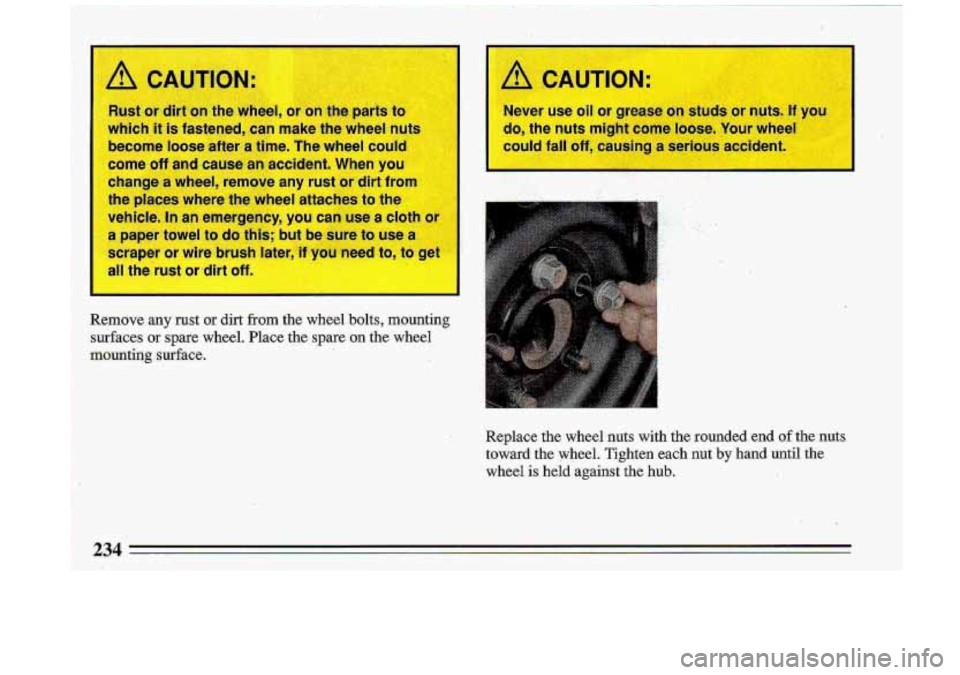
CAUTIO A
Rust or dirt on the wheel,
which it
is fastened, can make the wheel nu
become loose after a time. The wheel could
come
off and cause an accident. When you
change
a wheel, remove any rust or dirt fro1
the places where the wheel attaches to the
vehicle. In an emergency, you can use
a cloth or
a paper towel to
do this; but be sure to use a
scraper or wire brush later, if you need to, to get
all the r---t or dirt off.
N use oil or gre
e on stu
Remove any rust or dirt fro-rn the wheel bolts, rnoullLl1lg
surfaces or spare wheel. Place the spare on the wheel
mounting surface.
Replace.
the wheel nuts with the rounded end of the nuts
toward the wheel. Tighten each nut by hand until the
wheel is held against the hub.
234
Page 254 of 340
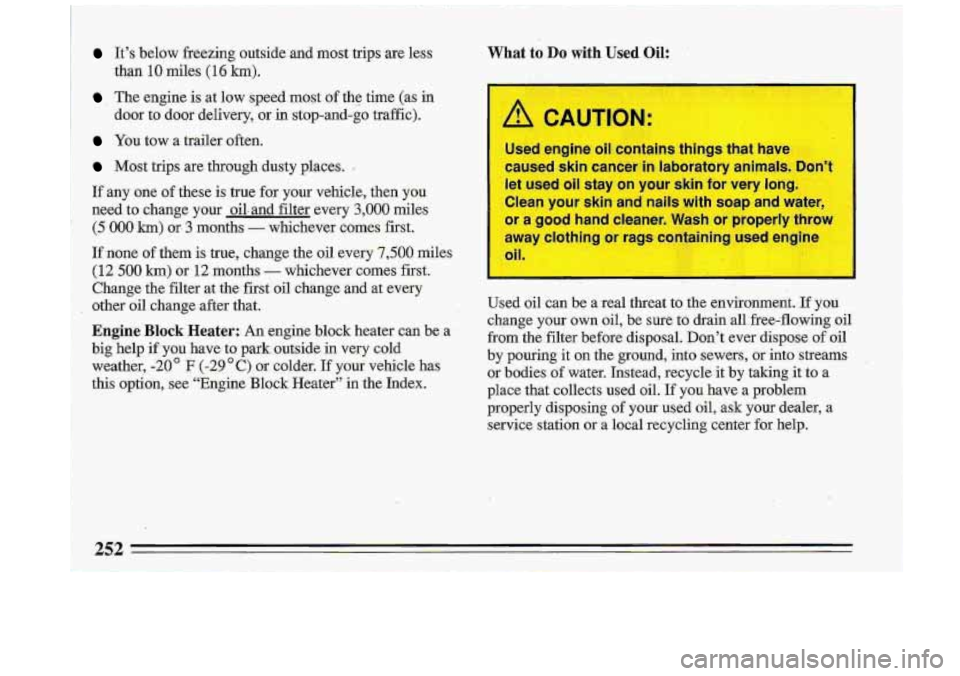
It’s below freezing outside and most trips are less:
than
10 miles (16 km).
. The engine is -at low .speed most of the time (as in
door
tp door delivery, or in stop-and-go traffic).
You tow a trailer often.
Most trips are through dusty places.
If -any one of these is true for your vehicle, then you
need-to change
your oil.and filter every 3,000 miles
(5 000 km) or, 3 months - whichever comes first.
If none of them is true, change the oil every 7,500 miles
(12 -500 km) or 12 months - whichever comes first.
Change the filter at the first oil change and
at every
other oil change after that.
Engine Block Heater: An engine block heater can be a
big help if-you have
to park outside in very cold
weather,
-20 * F (-29 C] or .colder. If your vehicle has
this option, see
“Engine Block Heater” in the Index.
What to Do with Used Oil:
Used engine oil contains things that have
caused skin cancer in laboratory animals.
Da
let used oil stay on your skin for very long
Clean your skin and nails with soap and water,
away clothing or rags containing used engine
0
lr a good hand cleaner. Wash or properly throw
I
..
Used oil can be a real threat to the environment. If you
change your
own oil, be sure to drain all free-flowing oil
Erom the filter before disposal. Don’t ever dispose of oil
by pouring
it on the ground, into sewers, or into streams
or bodies of water. Instead, recycle it by taking it.to a
place that collects used oil. If you have a problem
properly disposing of your used oil, ask your dealer, a
service station or
a local recycling center for help.
252
Page 256 of 340
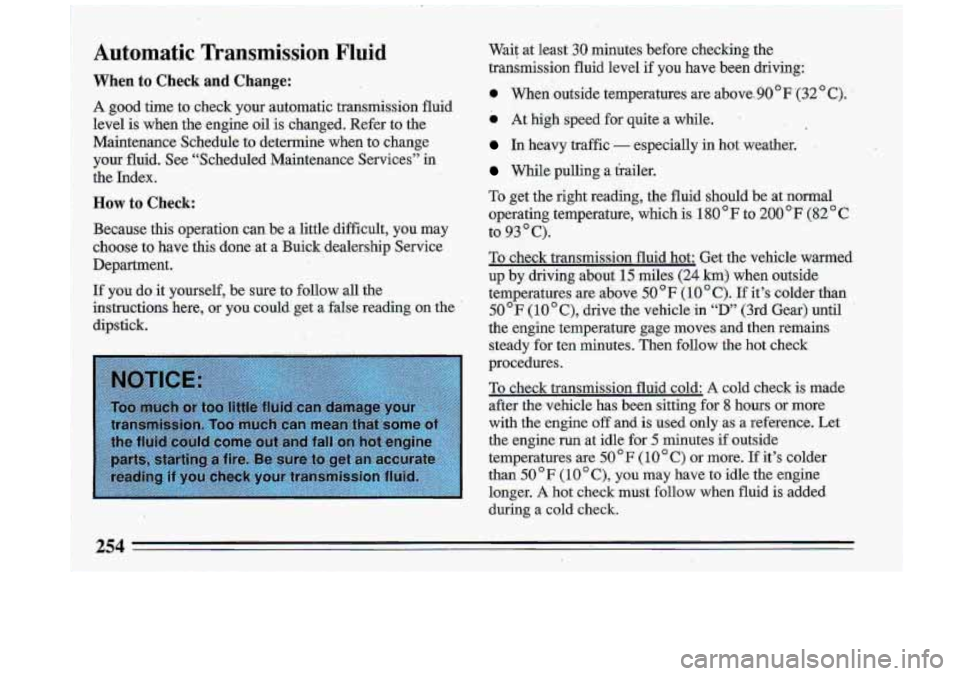
Automatic Transmission Fluid
When to Check and Change:
A good time to check your auiomatic transmission fluid
level is when the engine oil is changed. Refer to the
Maintenance Schedule to determine when to change
your fluid. See “Scheduled Maintenance Services” in
the Index.
How to Check:
Because this operation can be a little difficult, you may
choose to have this done at
a Buick,dealership Service
Department.
If
you do it yourself, be sure to follow all the
instructions here, or you could get a false reading on the
.
dipstick. Wait
at least
30 minutes before checking the
transmission fluid level
if you have been driving:
0 When outside temperatures are above. 90 F ‘(32 C);
0 At high speed for quite a while. I
In heavy traffic - &specially in hot weathEr.: . .
While pulling a trailer.
To get the right reading, the fluid should be at normal
operating temperature, which is
180 F to 200 *F (82 C
To check transmission fluid hot: Get the vehicle ‘warmed
up
by driving about 15 miles (24 krn) when outside
temperatures are above
50 F (1 0 C). If it’s colder than
50 F ( 10 C), drive the vehicle in “D” (3rd Gear) until
the engine temperature gage moves and then remains
steady for ten minutes. Then follow the hot check
procedures.
To check transmission fluid cold: A cold check is made
after the vehicle has been sitting for
8 hours or more
with the engine
off and is used only as a reference. Let
the engine run at idle for
5 minutes if outside
temperatures are
50 F (10 C) or more. If ‘it’s colder
than
50 OF (10 * C), you may have to idle the engine
longer.
A hot check must €0110~ when fluid is added
during
a cold check.
..
to 93 C).
254
Page 266 of 340
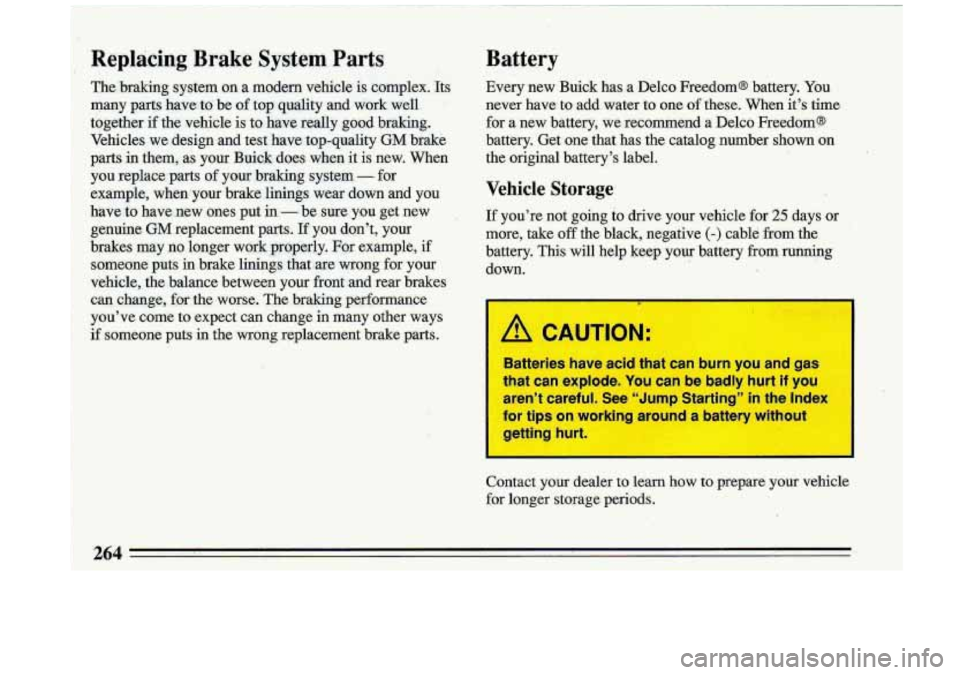
Replacing Brake System Parts
The braking system on a modem vehicle is complex. Its
many parts have to’ be of top quality and work. well
together if the vehicle is to have really good braking.
Vehicles we design and test have top-quality
GM brake
parts in them, as your: Buick, does when it is new. When
you replace parts
of your braking system - for
example, when.your brake linings wear down and you
have-to have
new ones put in - be sure you get new
genuine
GM replacement parts. If you don’t, your
brakes may no longer work properly. For example,
if
someone puts in brake linings that are wrong for your
vehicle, the balance between
your front and rear brakes
can change, for the worse.
The braking performance
you’ve come to expect can change
in many other ways
if someone puts in the wrong replacement brake parts.
Battery
Every new Buick has a,Delco Freedom@ battery. You
never have.to add water
to one of these. When it’s time
for a new battery, we recommend a Delco Freedom@
battery. Get one that has the catalog number shown
on
the original battery’s label.
Vehicle Storage,
If you’re not going to drive your vehicle for 25 days or
more, take
off the black, negative (-) cable from the
battery. This
will help keep your battery from running
down.
Batteries have acid that can burn you and gat
that can explode. You can be badly hurt
if you
aren’t careful. See “Jump Starting” in the lndl
for tips on working around a battery without getting hurt.
Contact your dealer to learn how to prepare your vehicle
for longer storage periods.
264 -